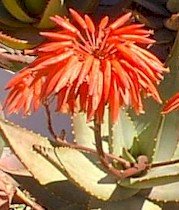Euphorbia species
It is extraordinary how many Euphorbia there are and how much they differ from each other. The only way to know they are related is by the flowers.Here is a photo of the tiny ground cover. The leaves are very small in dry weather. I added my finger tip for scale.
It was only recently that I found out that this old favorite ground cover was in fact an Euphorbia!
Never forget that the milky sap or latex of the Euphorbia plant is highly toxic. Especially in the eyes. There is one very fierce large tree size Euphorbia in the northern parts of South Africa where it is dangerous in habitat where those large plants grow to walk downwind when they are in bloom. Your eyes will start burning and you better cover the eyes and nose with a piece of cloth quickly.
Surprisingly the bees and butterflies love the flowers !
There are animals - even domestic cattle - that eat some of the Euphorbia species. This is life saving for the animals in Namaqualand and the Karoo.
I would like an assortment Euphorbia between the aloe
plants but most of the pretty or odd ones are rather difficult plants out of their habitat.








